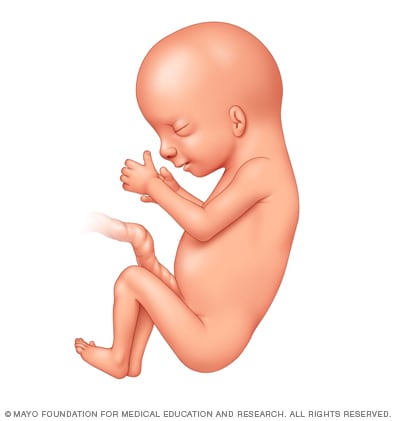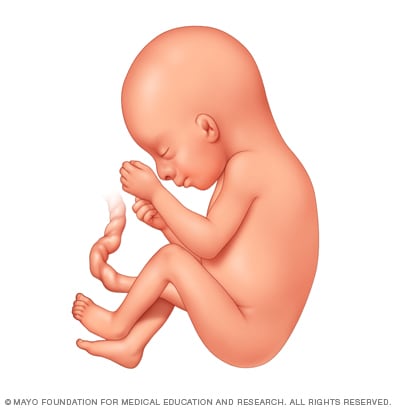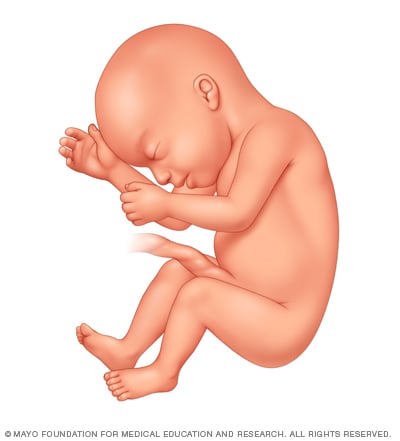Fetal development: The second trimester
Highlights of fetal development during the second trimester may include finding out your baby's sex and feeling the baby move.
By Mayo Clinic Staff
As pregnancy moves into the second trimester, your baby may begin to seem more real. At four weeks of pregnancy, your baby was a cluster of cells. At 11 weeks, the unborn baby became a fetus. Now, the organs, nerves, and muscles are starting to work. Use this information to follow along with what's happening week by week during the second trimester.
As you track your pregnancy, remember that to find your estimated due date, your healthcare professional counts ahead 40 weeks from the start of your last period. That means you're actually not pregnant the first week or two of what's counted as your pregnancy's 40-week timeline.
Week 13: Bones start to harden
Thirteen weeks into pregnancy, or 11 weeks after conception, bones start to harden in your baby's skeleton, especially in the skull and long bones of the arms and legs. The skin is thin and transparent. But soon it will start to get thicker.
Week 14: Red blood cells form
Fourteen weeks into pregnancy, or 12 weeks after conception, your baby's neck has become more defined. And red blood cells are forming in the spleen. Your baby's sex likely will become clearer this week.
By now, your baby might be almost 3 1/2 inches (87 millimeters) long from the top of the head to the bottom of the tailbone, called crown to rump, and weigh about 1 1/2 ounces (45 grams).
Week 15: Bone development continues
Fifteen weeks into your pregnancy, or 13 weeks after conception, your baby is growing quickly. Bone development continues. Soon you'll be able to see bones on ultrasound images. Your baby's scalp hair pattern also is forming.
Week 16: Eyes move
Fetal development 14 weeks after conception
Fetal development 14 weeks after conception

Fetal development 14 weeks after conception
By the end of the 16th week of pregnancy, or 14 weeks after conception, your baby's limb movements are becoming more coordinated.
Sixteen weeks into pregnancy, or 14 weeks after conception, your baby's head is upright. The eyes can move slowly, and the ears are close to reaching their final position. The skin is getting thicker.
Limb movements are becoming coordinated and can be seen during ultrasound exams. But those movements likely are too small for you to feel.
By now, your baby might be about 4 3/4 inches (120 millimeters) long from crown to rump and weigh about 4 ounces (110 grams).
Week 17: Toenails develop
Seventeen weeks into your pregnancy, or 15 weeks after conception, toenails start developing.
Your baby is becoming more active, rolling and flipping. Although you might not be able to feel those movements yet, you may feel your baby hiccuping, which causes small jerking movements.
Week 18: Hearing develops
Eighteen weeks into pregnancy, or 16 weeks after conception, your baby's ears start to stand out on the head. Your baby also might begin to hear sounds. The digestive system has started working.
By now, your baby might be about 5 1/2 inches (140 millimeters) long from crown to rump and weigh 7 ounces (200 grams).
Week 19: A protective coating forms
Nineteen weeks into your pregnancy, or 17 weeks after conception, growth slows.
A greasy, cheeselike coating called vernix caseosa starts to cover your baby. The vernix caseosa helps protect your baby's delicate skin from scrapes, chapping, and hardening that can happen from being in contact with amniotic fluid.
Your baby also is starting to release urine that now makes up most of the amniotic fluid.
Week 20: The halfway point
Halfway into your pregnancy, or 18 weeks after conception, you might be able to feel your baby's movements. This sometimes is called quickening. Your baby is regularly sleeping and waking and might be wakened by noises or your movements.
By now, your baby might be about 6 1/3 inches (160 millimeters) long from crown to rump and weigh about 11 ounces (320 grams).
Week 21: Baby can suck a thumb
Fetal development 19 weeks after conception
Fetal development 19 weeks after conception

Fetal development 19 weeks after conception
By the end of the 21st week of pregnancy, or 19 weeks after conception, your baby might suck a thumb.
Twenty-one weeks into pregnancy, or 19 weeks after conception, your baby is completely covered with a fine, downy hair called lanugo. The lanugo helps hold the vernix caseosa on the skin.
The sucking reflex also is developing, so your baby may be able to suck a thumb.
Week 22: Hair becomes visible
Twenty-two weeks into pregnancy, or 20 weeks after conception, your baby's eyebrows and hair are visible.
In the male reproductive system, the testes have begun to move down into the scrotum. In the female reproductive system, the uterus and ovaries are in place, and the vagina is developed.
By now, your baby might be about 7 1/2 inches (190 millimeters) long from crown to rump and weigh about 1 pound (460 grams).
Week 23: Fingerprints and footprints form
Twenty-three weeks into your pregnancy, or 21 weeks after conception, your baby starts to have rapid eye movements. Ridges also form in the palms of the hands and soles of the feet that will create the foundation for fingerprints and footprints.
The lungs are starting to make a substance called surfactant. It allows the air sacs in the lungs to inflate and keeps the lungs from collapsing and sticking together when they deflate.
If born preterm, some babies this far along in pregnancy may be able to survive outside the uterus.
Week 24: Skin is wrinkled
Twenty-four weeks into pregnancy, or 22 weeks after conception, your baby's skin is wrinkled and see-through. The skin tends to have a pink or red tint due to blood moving through the blood vessels.
By now, your baby might be about 8 1/4 inches (210 millimeters) long from crown to rump and weigh more than 1 1/3 pounds (630 grams).
Week 25: Baby responds to your voice
Fetal development 23 weeks after conception
Fetal development 23 weeks after conception

Fetal development 23 weeks after conception
By the end of the 25th week of pregnancy, or 23 weeks after conception, your baby might be able to respond to your voice with movement.
Twenty-five weeks into your pregnancy, or 23 weeks after conception, your baby might move in response to familiar sounds, such as your voice.
At this point, your baby spends most sleep time in rapid eye movement. That's when the eyes move quickly even though the eyelids are closed.
Week 26: Eyebrows and eyelashes form
By 26 weeks into your pregnancy, or 24 weeks after conception, eyebrows and eyelashes have formed. Your baby's eyes also are developed, but they may not open for another two weeks.
By now, your baby might be 9 inches (230 millimeters) long from crown to rump and weigh nearly 2 pounds (820 grams).
Week 27: Second trimester ends
This week marks the end of the second trimester. At 27 weeks, or 25 weeks after conception, your baby's nervous system is continuing to mature. Your baby also is gaining fat, which helps the skin look smoother. This fat gain will continue into the third trimester.
March 18, 2025
- Frequently asked questions: How your fetus grows during pregnancy. American College of Obstetricians and Gynecologists. https://www.acog.org/patient-resources/faqs/pregnancy/how-your-fetus-grows-during-pregnancy. Accessed Jan. 30, 2025.
- Persaud TVN, et al. Fetal period: Ninth week to birth. In: The Developing Human: Clinically Oriented Embryology. 12th ed. Elsevier; 2025. https://www.clinicalkey.com. Accessed Feb. 5, 2025.
- Wick MJ, ed. Mayo Clinic Guide to a Healthy Pregnancy. 3rd ed. Mayo Clinic Press; 2024.
- Stages of pregnancy. Office on Women's Health. https://www.womenshealth.gov/pregnancy/youre-pregnant-now-what/stages-pregnancy. Accessed Jan. 30, 2025.